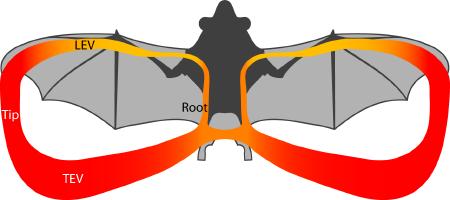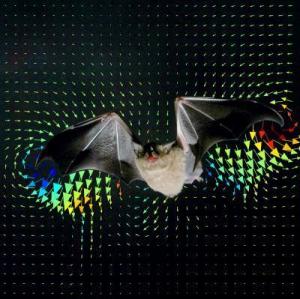Sometimes scientists won't understand it even after they see it, but at least they'll believe it despite its improbability. Such is the case with bats, the bumblebee and the hummingbird, which according to classic wing theory should not be able to fly. Yet they seem to have forgotten to read that textbook.
In 1995, bumblebee flight got its answer. This week, the aerodynamics of a hovering bat species has been revealed. Its flight was studied in the wind tunnel laboratory of Lund University.
The wind tunnel at Lund University is specially crafted for research on bird flight. Birds fly “at the spot” against a headwind, allowing detailed investigation of wing movements using high speed video cameras. It’s also possible to visualize the vortices around the wings and in the wake using fog as tracer particles.

In 2003 professor Anders Hedenström investigated the aerodynamics of bird flight using this method for the first time. In the spring of 2007 his lab presented results from flying bats for the first time. A nectar-feeding bat species, Palla’s long-tongued bat, was trained to visit a feeder in the wind tunnel. By varying the speed between 0 m/s (hovering) to 7 m/s, different behaviors were studied.
"When we investigated the aerodynamics of our bats we discovered that the wings generated more lift than they should at the slowest speeds (as dictated by classic wing theory)," says professor Hedenström.
"We recorded vortices shed in the wake, which we know well from our previous studies on birds. Now, our new study show that a stable leading edge vortex (LEV) is developed on top of the wing, and this vortex adds significant amounts of lift. Such vortices were previously known in insects, for example in bumblebees, and it was the discovery of leading edge vortices that finally resolved the bumblebee flight conundrum."

How can the bats generate such high lift? One of the team members and lead author of the new study, Florian Muijres, explains:
"The high lift arises because the bats can actively change the shape (curvature) by their elongated fingers and by muscle fibers in their membranous wing. A bumblebee cannot do this; its wings are stiff. This is compensated for by the wing-beat frequency. Bats beat their wings up to 17 times per second while the bumblebee can approach 200 wing-beats per second."
Article: F. T. Muijres, L. C. Johansson, R. Barfield, M. Wolf, G. R. Spedding, A. Hedenström, Leading-Edge Vortex Improves Lift in Slow-Flying Bats, Science 29 February 2008: Vol. 319. no. 5867, pp. 1250 - 1253, DOI: 10.1126/science.1153019





Comments